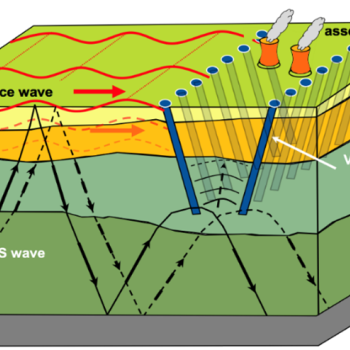Seismic Cloaking Structure Design to Protect High-Value Assets from Hazardous Earthquakes

Seismic waves present a significant problem for structures and people living under and near the earth's surface, causing geological instability and potential damage to buildings and infrastructure. The destructive power of seismic waves, such as those caused by earthquakes, necessitates the development of countermeasures, including damping structures, to manage the effects of seismic waves. Existing approaches are confronted with challenges posed by the vast scales of wavelengths and power associated with seismic waves. Attenuating the effects of seismic activity involves manipulating the energy of these waves, which is easier said than done. Existing technologies often struggle to provide a large enough protection zone and have difficulties in making the technology economically viable.
Technology Description
The technology involves a seismic wave damping structure. It includes at least one pair of structural elements, each angled and extending into the earth and toward a protection zone. These elements form a tapered aperture and define the protection zone at the upper portion of this opening. Each element defines an inner volume and contains a medium. This medium resists the passage of anticipated seismic waves with a wavelength greater than the cross-sectional dimension of the element's inner volume. The medium can consist of air, gas, water, or a viscous fluid. What differentiates this technology is its specific design and functionality. The elements are arranged and configured to reduce the power of the projected seismic wave within the protection zone. The composition and placement of elements allow for the attenuation of the power arising from anticipated seismic waves. These features distinguish the technology from others because it manipulates the energy of seismic waves to a greater degree within a specific, defined area.
Benefits
- Effective seismic damage mitigation resulting from the structure's ability to attenuate the power of seismic waves, reducing potential damage
- Defined protection zone allows the technology to target and plan for a specific area to be protected
- Use of different media, such as air, gas, water, and viscous fluid, provides flexibility in implementation
- Increased safety in safeguarding lives and infrastructure from the destructive effects of seismic activity
Potential Use Cases
- Infrastructure protection: Provides damping structures near essential facilities for safety against seismic activities
- Residential buildings: Allows construction of safe spaces within residential areas to reduce seismic damage
- Public safety: Allows implementation in public places like parks and open spaces
- Commercial structures: Safeguards buildings from seismic damage
- Gas and oil extraction sites: Mitigates seismic risks at sites that are susceptible to seismic activity